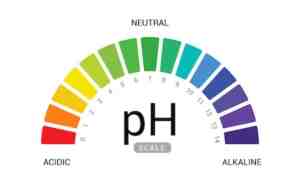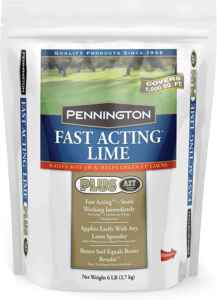How Much Lime Does My Lawn Need?
A lush green lawn is the pride of every homeowner. However, getting your lawn to look its best requires more than just watering and mowing. The soil’s pH level and the size of the lawn are the two critical factors that can make or break your lawn’s appearance. Soil with an incorrect pH level can cause poor growth, nutrient deficiencies, and disease susceptibility. Adding lime to your lawn can help balance the pH level, but how much lime should you add?
Unsure how much lime your lawn needs? Learn how to calculate the ideal dosage for your lawn based on the soil pH in the following article.
What is Lime and Why is it Important for Your Lawn?
Lime is a soil amendment that helps to neutralize soil acidity. Soil with a high acidity level (low pH level) makes it difficult for grass to absorb essential nutrients. Lime’s primary function is to increase the soil pH level, allowing the grass roots to access the necessary nutrients.
Lime is available in different forms, including dolomitic lime, calcitic lime, and pelletized lime. Dolomitic lime contains both magnesium and calcium, making it ideal for soil with low magnesium levels. Calcitic lime contains only calcium, which makes it ideal for soil with high magnesium levels. Pelletized lime is easier to apply and reduces dust during application.
How to Determine the Ideal Lime Dosage for Your Lawn
Determining the ideal lime dosage for your lawn depends on the soil pH level and grass type.
Test Your Soil
The first step in determining the ideal lime dosage for your lawn is to test your soil. Soil test kits are readily available at most garden centers or can be ordered online. Alternatively, you can send a soil sample to a professional laboratory for a comprehensive analysis.
Soil test kits typically measure the soil pH level, nutrient levels, and organic matter content. The pH level is the most critical factor to consider when determining the ideal lime dosage. The ideal pH level for most grass types is between 6.0 and 7.0.

Determine Your Grass Type
The next step is to determine your grass type. Different grass types have different lime requirements. Determining your grass type is an essential step in calculating the ideal lime dosage for your lawn. Different grass types have different requirements when it comes to soil pH levels and nutrient absorption. Here are some ways to help you identify your grass type:
- Observe the Color and Texture of the Grass: Look closely at the color and texture of the grass in your lawn. Warm-season grasses, such as Bermuda grass and Zoysia grass, tend to have a darker green color and a coarser texture. Cool-season grasses, such as Kentucky Bluegrass and Fescue, have a lighter green color and a finer texture.
- Look at the Blade Width: Warm-season grasses have a wider blade width than cool-season grasses. Bermuda grass, for example, has a blade width of 2-3mm, while Kentucky Bluegrass has a blade width of 1-2mm.
- Check the Growth Pattern: Warm-season grasses grow best in warm temperatures and tend to grow faster during the summer months. Cool-season grasses, on the other hand, grow best in cooler temperatures and tend to grow faster during the spring and fall months.
- Consider Your Location: Grass types can vary based on location and climate. Research the common grass types in your area to help you determine which type you have.
Once you have identified your grass type, you can then use this information, along with your soil pH level, to calculate the ideal lime dosage for your lawn.
Calculate the Ideal Lime Dosage
Once you know your soil pH level, you can use the following formula to calculate the ideal lime dosage:
Ideal Lime Dosage (lbs/1000 sq. ft.) = (desired pH level – current pH level) x 6
For example, if your soil pH level is 5.5, and you want to raise it to 6.5, the ideal lime dosage would be:
Ideal Lime Dosage = (6.5 – 5.5) x 6 = 6 lbs/1000 sq. ft.
It is important to note that this formula is only a general guide. It is always best to follow the recommended dosage on the lime package and consult with a professional if you are unsure.

Apply the Lime
After calculating the ideal lime dosage, it’s time to apply the lime to your lawn. The best time to apply lime is in the fall or spring when the soil is moist. Spread the lime evenly over the lawn using a spreader, rake, or by hand.
Test Your Soil Again
After applying the lime, it’s essential to test your soil again in 6 to 8 weeks. This will allow you to see if the lime has raised the pH level to the desired range. If the pH level is still below the ideal range, you may need to apply more lime.
FAQs
Q: Is it possible to add too much lime to my lawn?
A: Yes, it is possible to add too much lime to your lawn. Overliming can lead to an excessively high pH level, which can make it difficult for your grass to absorb nutrients. It’s always best to follow the recommended dosage on the lime package and consult with a professional if you are unsure.
Q: Can I apply lime any time of the year?
A: The best time to apply lime is in the fall or spring when the soil is moist. Avoid applying lime during the hot summer months or when the soil is dry.
Q: How long does it take for the lime to work?
A: It can take several months for the lime to raise the pH level to the desired range. It’s essential to test your soil again in 6 to 8 weeks after applying the lime.
Q: Can I apply lime if my lawn is already healthy?
A: Yes, applying lime can benefit a healthy lawn as well. It can help maintain the pH level in the soil, which can improve nutrient absorption and promote healthy growth.
Q: How often should I apply lime to my lawn?
A: The frequency of applying lime depends on the pH level of your soil and the grass type. In general, it’s recommended to apply lime every two to three years. However, if your soil pH level is consistently low, you may need to apply lime more frequently.
Q: Can I apply lime and fertilizer at the same time?
A: Yes, you can apply lime and fertilizer at the same time. However, it’s important to make sure that you are applying the correct amount of each. Lime should be applied based on the soil pH level, while fertilizer should be applied based on the nutrient needs of your grass. It’s always best to follow the recommended dosage on the product labels and consult with a professional if you are unsure.
Conclusion
Maintaining a healthy and lush green lawn requires more than just watering and mowing. The soil pH level and grass type are critical factors that can affect the growth and appearance of your lawn. If your soil pH level is too low, adding lime can help balance it and improve nutrient absorption. By following the steps outlined in this article, you can determine the ideal lime dosage for your lawn and achieve the perfect green lawn you’ve always wanted. So, if you’re unsure how much lime your lawn needs, learn how to calculate the ideal dosage for your lawn based on the soil pH and grass type, and start taking care of your lawn today.

